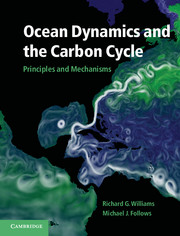Book contents
- Frontmatter
- Contents
- Preface
- Acknowledgements
- Illustration credits
- Part I Introduction
- Part II Fundamentals
- 3 Transport fundamentals
- 4 Physics fundamentals
- 5 Biological fundamentals
- 6 Carbonate chemistry fundamentals
- Part III Physical Phenomena and their Biogeochemical Signals
- Part IV Synthesis
- Appendix
- Symbols and definitions
- Glossary
- Answers
- References
- Index
- Plate section
4 - Physics fundamentals
from Part II - Fundamentals
Published online by Cambridge University Press: 05 June 2012
- Frontmatter
- Contents
- Preface
- Acknowledgements
- Illustration credits
- Part I Introduction
- Part II Fundamentals
- 3 Transport fundamentals
- 4 Physics fundamentals
- 5 Biological fundamentals
- 6 Carbonate chemistry fundamentals
- Part III Physical Phenomena and their Biogeochemical Signals
- Part IV Synthesis
- Appendix
- Symbols and definitions
- Glossary
- Answers
- References
- Index
- Plate section
Summary
The ocean circulates, redistributing heat, carbon and tracers over the globe. This advective transfer can be seen in how seaweed, floating debris and sediments are swept along the shoreline, as well as on a grander scale in how warm water is moved from the tropics for thousands of kilometres by the ocean before releasing its warmth to the atmosphere. Currents occur in a range of guises: as narrow, fast jets; meandering boundary currents; spinning vortices and vibrant eddies; as well as broad and weak interior flows.
Ocean currents are mainly driven by the frictional drag from the wind blowing over the sea and the air–sea exchange of heat and fresh water. While this forcing is comparatively easy to understand, the ocean's response is more complex. The crucial point to grasp is that the ocean flows take a long time to move any significant distance over the globe and, during that time, the spinning Earth completes many rotations around its axis; for example, even for fast currents, like the Gulf Stream moving at over 1 ms-1, the Earth completes 10 rotations in the time a water parcel takes to travel 1000 km. Consequently, the effects of the Earth's rotation need to be considered in order to understand the motion of any ocean current lasting a day or longer.
In this chapter, we explain how the ocean circulates, responding to accelerations on a rotating planet, in a broadly descriptive manner; accompanying mathematical expressions are summarised in boxes.
- Type
- Chapter
- Information
- Ocean Dynamics and the Carbon CyclePrinciples and Mechanisms, pp. 66 - 92Publisher: Cambridge University PressPrint publication year: 2011



